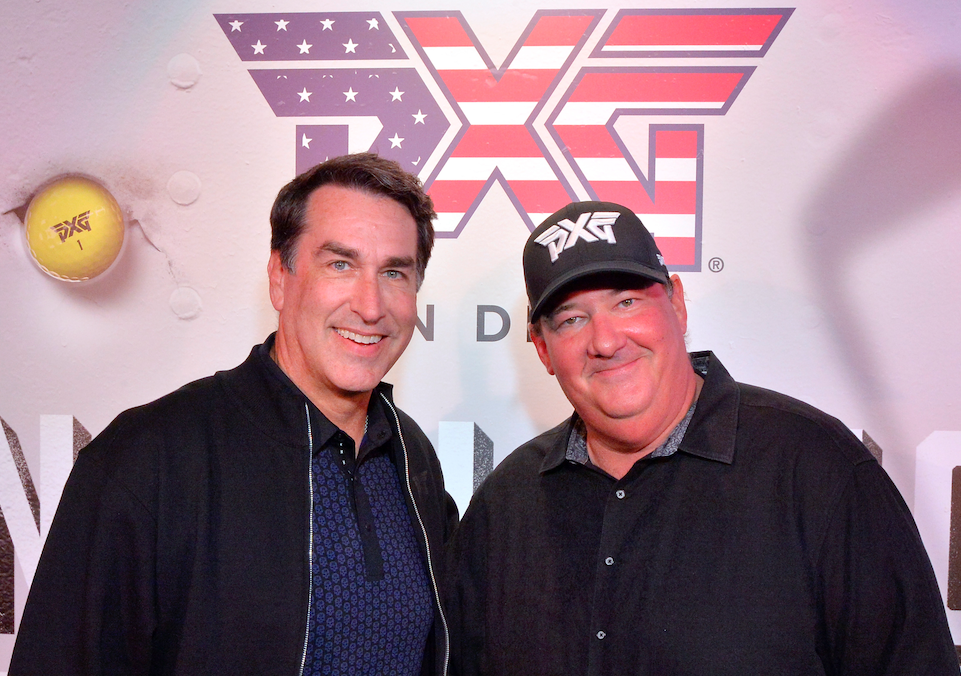We asked two of our PXG Ambassadors, Blair Wheeler and Cassandra Meyer, to share their views on fitness and how it has impacted the game of golf. We take a look inside both ambassadors fitness lifestyles and get a better understanding of all the benefits that being fit has added to their golf game from the tee box to the putting green.
Want more expert tips like this one? Then be sure to check out our other videos for even more golf fitness tips, club reviews, swing tips, and so much more! While you’re it, why not check out our pre-round and post-round fitness tips and really take your golf fitness to a whole new level!
Video Transcript
Blair:
What’s up guys? I’m here with my co-host of The Birdie Juice Podcast, Cassandra Meyer. We’re here at the new PXG location in Dallas, Texas. Really excited to talk to you guys today about one of our passions, fitness.
Cass:
Yeah. Golf and fitness.
Blair:
Golf and fitness. So we had a little long drive competition yesterday. I was dead set I could get the clubhead speed up over 120. I didn’t.
Cass:
I called that.
Blair:
Yeah, Cass called it in the car, “No way you’re getting 120.”
Cass:
He started out at 101, 102.
Cass:
What did we get up to? 112?
Blair:
I peaked at 115. So I peaked yesterday at 115, but I got 305 yardage, total yardage.
Cass:
I thought you got 310.
Blair:
310?
Cass:
310.
Blair:
Yeah, 310. My last one was 305.
Cass:
I was 311.
Blair:
She got me by a yard. But what I took from that was, I’ve got to work on my fitness a little more. I’ve got to work on my specific golf long drive fitness.
Cass:
Sequencing.
Blair:
There’s a lot of stuff I need to work on. But talking about fitness a little bit, I’ve got to get my clubhead speed up. You actually train for golf and for swing speed and for power. So what does that look like for you? Because I don’t, I just do CrossFit for vanity reasons. What’s your fitness routine look like?
Cass:
Yeah, so fitness has always been a big part of my life. My mom was always very into fitness, so I grew up watching her work out and just be a really strong woman. So it was always an inspiration to me to… I don’t know, I was just the weird little kid that wanted a six pack. I would go to bed and I would do a hundred sit ups before I went to sleep, at 10 years old.
Cass:
That was just what I wanted. And obviously, I had a really good role model in my mom, so it’s been a part of my life for a long time. But like you, I started out training just to be strong in aesthetic reasons or whatever. I just like doing the gym, I like lifting weights. But I didn’t necessarily start training for performance until much later, actually only a couple years ago. When I started making the transition into long drive and I realized how important it was for proper sequencing and ground up power. So I started learning a little bit more about performance training.
Cass:
And so it’s been an interesting transition for me, but I realized how important it is to… I just never really was into golf training. Some of it was maybe a little lame. It started to progress into training more athletically now in the last couple of years.
Cass:
But golf training in the past was more balance and mobility and stability but not a lot of strength or power training.
Cass:
And I love the direction that it’s been going the last couple of years. And obviously, we have a lot of the guys on tour that are making those changes. We have them to thank. But I’m just super pumped for the direction of fitness. And PXG is one of those brands, I think, that is putting some effort into bridging the gap there between golf and fitness.
Blair:
Well, with PXG’s relationship with the godfather of golf and fitness, Gary Player, it’s a natural fit.
Cass:
He was way ahead of his time.
Blair:
Yeah, very much so. I think there’s photos of him and Arnold Palmer and Jack Nicholas walking the course and those guys are smoking cigarettes and drinking Coca-Colas, and Gary Player’s off the side doing sit ups and pushups.
Blair:
Entirely different ball game and how he’s changed the game of golf and golf and fitness. But like you said, it’s become more athletic training. When I was growing up, to listen to the podcast, heard my story, if you follow us on Instagram, you know I played a lot of sports like football, baseball, basketball, soccer, golf, surfing. I was in the gym for a lot of those, especially with football and baseball. We had weightlifting we had to do. And I remember when I played golf in high school, my golf coach got mad at our whole team because we all wanted to lift weights. And he kept saying, “Lifting weights is going to ruin your golf swing. It’s going to ruin your golf game.”
Blair:
That’s been an old trope that I think in recent years, is starting to change. Because you have guys like Wyndham Clark, you have guys that are training for golf; they’re lifting weights; they’re doing explosive movements that you haven’t seen in the past.
Cass:
Which is strange that that was always the thought process behind golf, because it’s a rotational sport and it really requires a lot of power and ground force. So it’s strange that it took so long for people to figure out that training more like a baseball player trains or a hockey player trains, it does transfer onto the court and into your swing speed and your stabilities better.
Blair:
Yeah. And I think that whole trope comes from doing traditional bodybuilding. You go in the gym, you’re going to spot, you’re going to bench, you’re going to do curls, and you’re going to get bulky. And being bulky, typically leads to less mobility, less mobility typically leads to shorter muscles and harder to rotate and that sort of thing.
Blair:
But if you’re training properly, if you’re doing the right things like Cass has talked about, rotational training, dynamic training, working on-
Cass:
Yeah, more dynamic. Anything that helps with your sequencing. And it’s not necessarily just for power purposes, but if you have proper sequencing, your actual swing plan will improve. Without even trying, without getting a lesson.
Cass:
So there’s so many important aspects of it that transfer onto the golf course. If you’re training properly.
Blair:
Yeah. And what I was going to say is, that happened to me yesterday without even trying.
Cass:
Mm-hmm (affirmative).
Blair:
I’ve been working on my swing a lot, working on the mechanics because I fight a natural over the top move instance. I just fight the natural. My hips don’t rotate properly. But when I started to try to swing really, really, really hard, or I try to go after the ball on our long drive competition, everything got better. The sequencing got better, my hips started to clear more and I think it’s because I’ve been an athlete my whole life and my body just clicked in and you’re like, “All right, well, this is how you need to do this. This is how you need to hit the ball.”
Cass:
Well, it’s instinctual for you if you’ve been an athlete, you’ve played so many different sports. If you just get yourself moving a little bit more athletically, your body started moving a little bit more dynamically instead of you being caught up in your swing thoughts. And you were taking that slow back swing and it just wasn’t dynamic, it wasn’t athletic. And so when you were trying to just swing as hard as you could, all of a sudden your natural instincts from just being an athlete took over, and you started moving more dynamically. And that actually, in turn, helped his club base without him even thinking about it.
Blair:
So what you’re saying is, I have future in long drive?
Cass:
If you can somehow find another hundred yards then yeah. We’ll see you out there.
Blair:
We’ll see what we do in training [crosstalk 00:07:31], here at PXG Dallas. I could find at least another 20.


